Zoltán Kiss- Area Sales Manager - East Europe - Endrich GmbH.
SiTime MEMS Oscillators
5 September 2014

Summary :
Micro ElectroMechanicalSystems (MEMS) incorporate nanotechnology in the electro-mechanics. Miniaturized mechanical and electro-mechanical elements under the control of integrated microelectronics are encapsulated into a small vacuum chamber forming complete systems – that is the definition of MEMS. A number of functional elements, like sensors, actuators can be realized as MEMS transducers, devices that convert energy from one form to another. In the case of micro-sensors, the device converts a measured mechanical signal into an electrical signal. The possibilities provided by the MEMS technology by means of downsizing, cost effectiveness of the applied production methods open new areas of usage. One of these areas is the timing with MEMS based resonators that are tiny structures vibrating at high frequencies. This article will give overview through leading manufacturer SiTime’s devices and technologies.
Traditional resonators and oscillators
A resonator is such a device that oscillates at some frequencies, called its resonant frequencies, with greater amplitude than at others. These oscillations can be either electromagnetic or mechanical kind by generating waves or select specific frequencies from a signal. The widely used traditional crystal oscillators use the mechanical resonance of a vibrating crystal of piezoelectric material to create an electrical signal with a very precise frequency, which is used as a clock signal for microprocessors or for stabilizing signals for radio frequency systems. Quartz crystals are manufactured for frequencies from kilohertz to megahertz range. Clocking of digital electronics circuits was not complicated, usually taking a Pierce oscillator driven by the piezoelectric quartz crystal resonator provided an oscillating signal, that - after filtering a dividing down - was usable for most of the timing tasks. There are also oscillators, which use piezoelectric ceramic resonators inside instead of quartz crystal. Traditional quartz oscillators require custom machinery to cut, grind, and plate the resonator crystal, and the manufacturers are experts in handling them in order to achieve the required frequency and provide its stability for 20 years. However usually they do not have the expertise in analog electronics, the have to buy the analog die. If the devices are bought from outside vendors, a lot of extra cost could come up in order to achieve high quality levels. The complexity of the manufacturing process of the oscillators results a higher investment, higher manufacturing costs, longer lead times, and more quality issues. On the other hand semiconductor-clock manufacturers did not have the experience in the special way of packaging the quartz crystals that require vacuum-sealed ceramic packaging in order to reserve high Q factor. Keeping the two separate package for the resonator and the analog electronics had bad affect on the market need of miniaturization.
MEMS resonators - SiTime
For the past several decades, quartz crystal based oscillators, clock generators and resonators were the primary reference timing components in electronics, since there were no real alternatives. Recently a new technology rose up, offering the first devices where the MEMS structures are built in the same package with the analog circuitry. MEMS resonators are connected to the MEMS-specific circuit blocks on the analog IC and are driven through electrostatic excitation. A MEMS bias generator is used to bias the electrostatic transducers that are built in the MEMS die. The resonator sustaining circuit brings the resonator into mechanical oscillation that is sensed, and the analog oscillator die can provide multiple clock outputs from a single, compact semiconductor package.
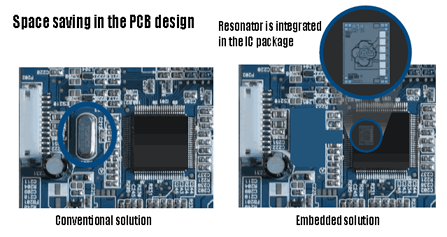
SiTime, an analog semiconductor company , whose MEMS technology has roots in Bosch and Stanford University, offers solutions that are replacing traditional quartz crystal based oscillator products by offering higher performance and reliability at a lower cost. SiTime has introduced a combo chip solution that stacks the MEMS structure on top of standard CMOS dice to supply all their timing signals. A key advantage is the ability of the MEMS chip to set up as factory default several clock frequencies on a single chip. The combined MEMS-CMOS solution offers significant benefits such as smaller footprint and less complex chips.
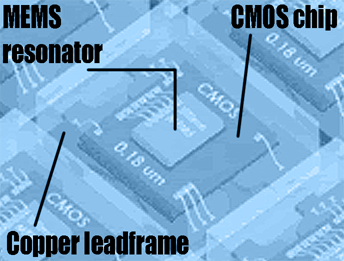
Their products are supported by factory programmability, and offer drop-in replacements for quartz oscillators without any design changes. The programmable architecture enables flexible product design and fast lead-times, offering in the same time downsizing, with up to 85% space reduction. Designers may also order Time Machine II programmer to program SiTime oscillators in their own facility to quickly develop prototypes. SiTime combined the MEMS and analog electronics on a single die, therefore no need to package the resonator and the analog electronics separately.
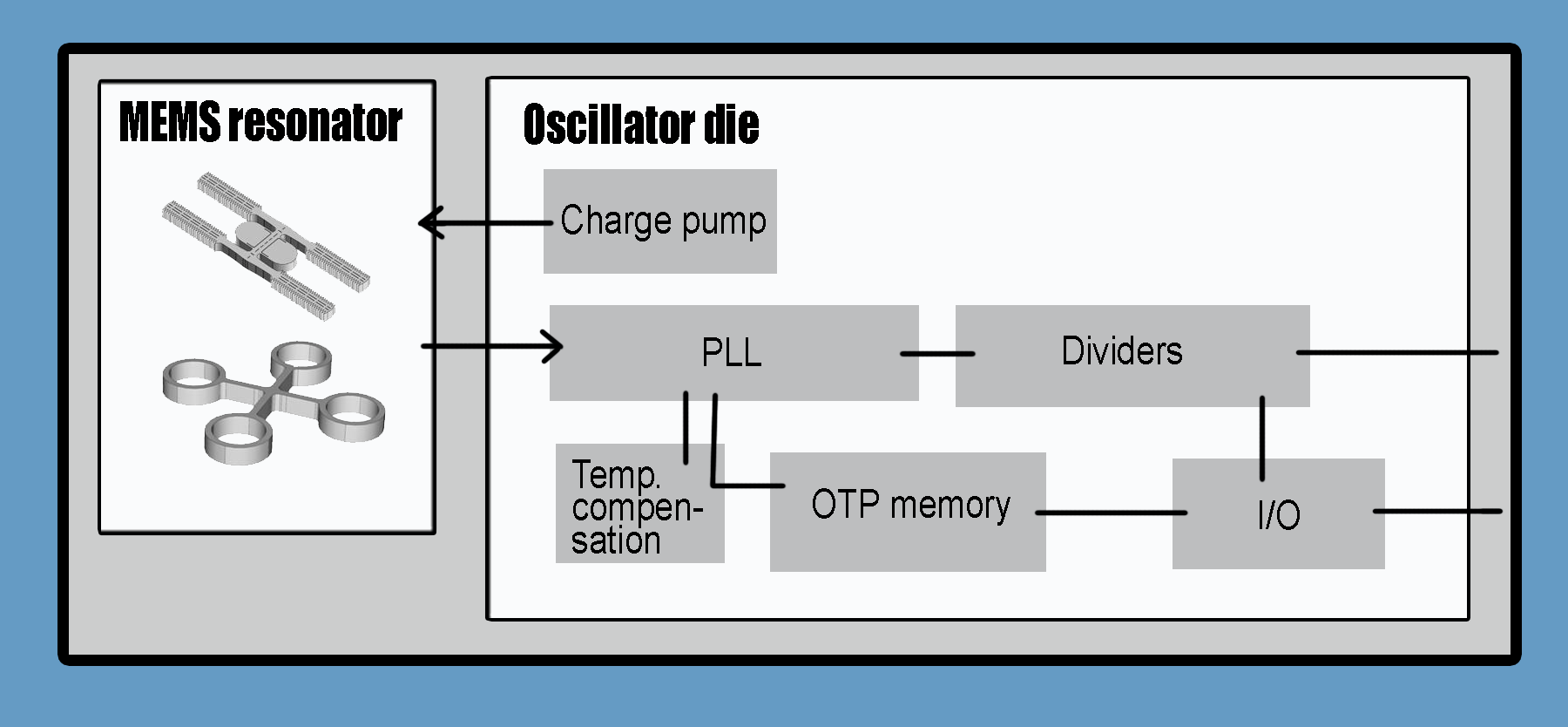
As seen on the figure, the device provides temperature compensation - to minimize the frequency drift as temperature changes- , output drivers and one-time programmable memory. SiTime has been able to design kilohertz devices with jitter as low as 500 fs, stability as low as 0.1 ppm, and very low (700 nA) power consumption. Programmable parameters include e.g. rise and fall times to reduce EMI, improve jitter, or drive any kind of loads; frequency to six decimals of accuracy; and stability, temperature, and signaling level (LVPECL or LVDS).
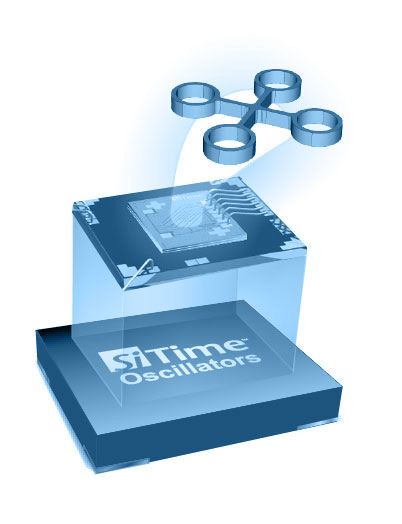
Benefits of MEMS resonators vs. conventional crystal oscillators
The biggest enemy of MEMS oscillators is moisture, which can condense on the tiny resonator during operation, causing changing its frequency. The "MEMS-first" process solves that problem by sealing the MEMS cavity in silicon at extremely high temperatures, making it impossible for moisture or stray gases to be sealed in. "MEMS-last" process technique waits until the very last step to put a glass cap on a wafer at relatively low temperatures. Bosch and SiTime are considered to be the only two MEMS fabricators using the MEMS-first approach. Till today, the strongest argument to stay with conventional quartz resonators was their low price and predictable temperature stability (see red curve on the figure). A MEMS resonator’s characteristic is typically nearly a vertical line, so for the oscillators based on these kinds of resonators the temperature compensation circuitry is a must to have feature. Originally SiTIME’s MEMS resonators had 30 ppm/C frequency stability variation, which is in fact 4000 ppm over the whole operational temperature range of -40 – 85C before temperature compensation in the analog electronics reduced this to 0.1 ppm, while conventional quartzes usually achieve 0,4 ppm/C. The newest TempFlat MEMS devices differ from previous MEMS oscillators, as they are the first MEMS resonators that natively outperform quartz resonators without temperature compensation circuitry. The characteristics shown on the figure is based on real measurement.
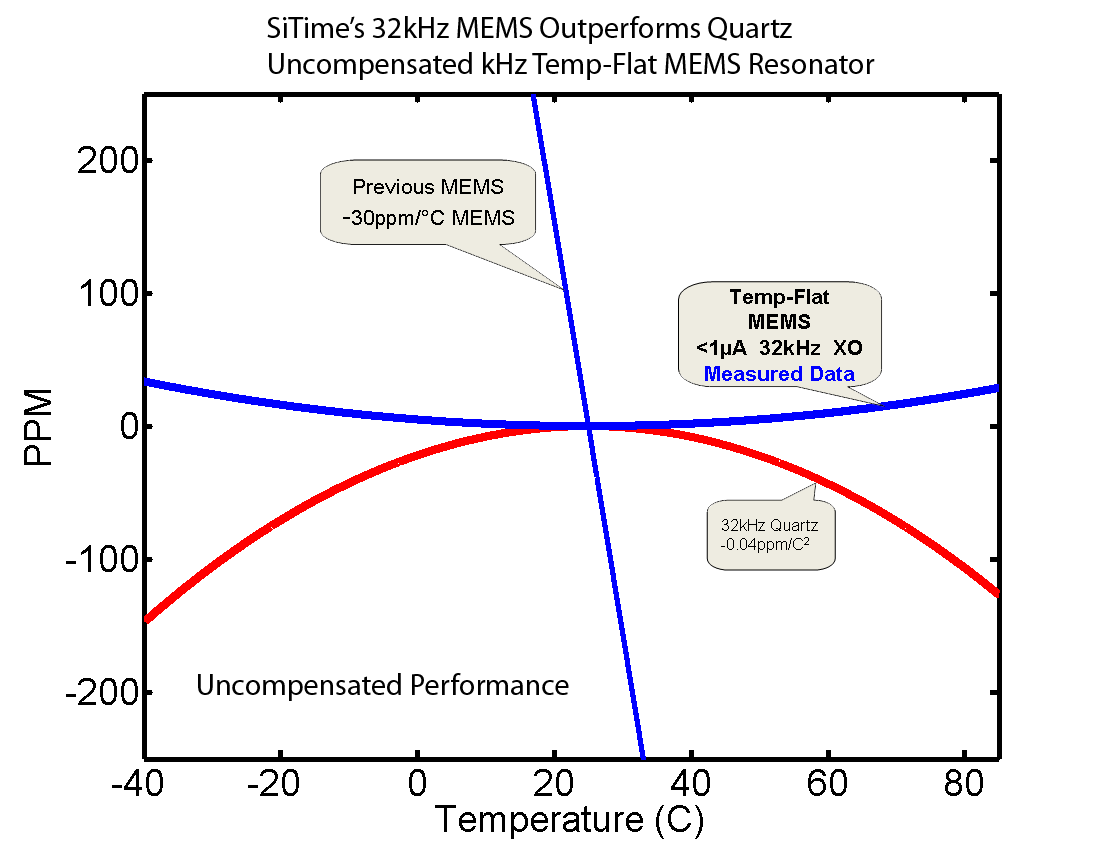
The table below compares quartz oscillators with SiTime's Silicon MEMS timing devices.
| Quartz | MEMS | ||
|---|---|---|---|
| Performance | ***+ | ***** | Better stability, aging |
| Feature | **+ | ***** | Programmable silicon |
| Availability | * | ***** | Very short lead-time |
| Reliability (MTBF) | *+ | ***** | Better Frequency Stability over Temperature; Lower Phase Noise and Jitter |
| Price | * | ***** | Silicon cost |
| SOC integration | ***** | Quartz cannot be integrated | |
| Size | ***** | Up to 85% | |
| EMI sensitivity | ***** | 54X better than quartz | |
| PSUP noise | *+ | ***** | 3Xbetter than quartz |
| Vibration sensitivity | * | ***** | 30X better than quartz |
| Shock sensitivity | *+ | ***** | 25X better than quartz |
Customers can order any combination of frequencies, voltages and frequency stabilities (PPM) in a range of industry-standard packages. SiTime oscillators offer any frequency within the operating range with up to 6 decimal places of accuracy. With custom frequencies, designers can increase system performance (microprocessor / FPGA applications) and reduce bit error rates (Ethernet applications). Because the devices are made with standard CMOS silicon techniques, they are easier and heaper to manufacture than crystal oscillators, that require special producing and packaging techniques. As the manufacturing process involves fewer participants, the costs are minimized, as well as the time to first sample. Customer benefits not only from the lower price, but also the lower lead-time makes it possible to reduce the investment costs. As MEMS devices offer more features (e.g. programmability), design costs are also less. As reliability is higher, the end product will be of a high brand value.
SiTime highlights
SiTime’s SiT15xx series oscillators are the smallest available ones for 32 kHz timing applications. They combine a MEMS resonator with a fractional-N PLL synthesizer and different dividers to provide frequency from 1 Hz to 32,768 kHz. The small 1.5X0.8x0.55 m package parts have a 100 ppm stability, low (0.75uA) consumption and very good shock and vibration resistance. There are family members that are fixed frequency devices (32,768 kHz), others are frequency programmable, and operate from 1.2 to 3.6V or 2,7-4,5V supplies, respectively. The SIT8102 introduced already in 2008 is the lowest jitter programmable oscillator aiming SATA, Fiberchannel, Firewire, Ethernet and PCI Express markets. The SiT8002XT is the thinnest programmable oscillator with typical 250 microns height. This product targets the portable application field, such as smartcards, Flash storage devices and cellular phones. SiT8920 as a 100% pin-to-pin drip in replacement for existing quartz oscillators, achieving +/-25 ppm frequency stability over the entire temperature range from -55 C to 125 C. SiTime's MEMS-based silicon timing product portfolio offers solutions for a wide range of applications. As drop-in replacements for quartz devices, SiTime's oscillators and clock generators are successfully replacing the quartz timing to silicon-based products. Further technical information as well as samples could be requested at the author.
| Share on Facebook | Share on LinkedIn |
References
This article has been published on the following locations:
| # | Media | Link |
|---|---|---|
| 1 | Elektronet 2014/5 | Elektronet : elektronikai informatikai szakfolyóirat, 2014. (23. évf.) 5. sz. 28-29. old. |
| 2 | Elektronet online | SiTime MEMS oszcillátorok |
| 3 | Hungarian version | SiTime MEMS oszcillátorok |
| 4 | TechStory M2M | MEMS technológia az időzítés területén |
| 5 | Revista Española de Electrónica 2016/2 | Osciladores - MEMS de SiTime |


